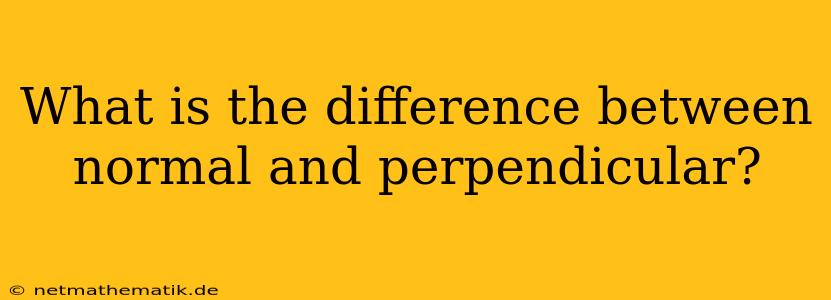Understanding the difference between normal and perpendicular is crucial in various fields like geometry, physics, and engineering. While the terms are often used interchangeably, there are subtle but significant distinctions that influence how we approach different problems and concepts. This article will delve into the definitions, applications, and key differences between normal and perpendicular, providing a comprehensive understanding of these essential geometric concepts.
Understanding the Concepts: Normal vs. Perpendicular
Before delving into the differences, let's define each term:
Normal
A normal is a line, ray, or vector that is perpendicular to a given line, curve, or surface at a specific point. It's important to remember that the normal is always perpendicular to the given object at that point.
Perpendicular
Perpendicular lines or objects are those that intersect at a right angle (90 degrees). This definition is more general and applies to any two lines or objects that intersect at a right angle, regardless of whether they are considered "normal" to each other.
Key Differences Between Normal and Perpendicular
While both terms refer to right angles, there are key distinctions between normal and perpendicular:
-
Specificity: Normal lines, rays, or vectors are specifically perpendicular to a specific point on a line, curve, or surface. Perpendicular, on the other hand, is a more general term that simply describes any two lines or objects intersecting at a right angle.
-
Direction: A normal always points outwards from the object it is perpendicular to. For instance, a normal to a curve would point outwards from the curve, while a normal to a surface would point outwards from the surface. Perpendicularity, however, does not specify a direction.
-
Applications: Normals have specific applications in various fields, including:
- Geometry: Finding the equation of a tangent line to a curve.
- Physics: Calculating the direction of a force acting on an object.
- Computer Graphics: Creating realistic reflections and shading effects.
Perpendicular lines, on the other hand, are used widely in various fields, including:
- Geometry: Constructing squares and rectangles.
- Engineering: Designing structures and machinery.
- Everyday Life: Finding the shortest distance between two points.
Examples to Illustrate the Difference
To further understand the difference, let's consider some examples:
Normal
-
Normal to a Line: Imagine a straight line. At any point on this line, an infinite number of lines can be drawn perpendicular to it. However, only one of these lines will be the normal to the line at that specific point. It will point outwards from the line, perpendicular to the line's direction.
-
Normal to a Curve: Consider a curved line. At any point on this curve, there will be a single line that is perpendicular to the tangent line at that point. This line is the normal to the curve at that point.
Perpendicular
-
Perpendicular Lines: Imagine two lines intersecting at a right angle. Both lines are perpendicular to each other.
-
Perpendicular Planes: Consider two planes intersecting at a right angle. Both planes are perpendicular to each other.
Conclusion: Normal and Perpendicular in Perspective
While the terms normal and perpendicular are often used interchangeably, understanding their distinctions is crucial. Normal is a more specific term that refers to a line, ray, or vector perpendicular to a specific object at a specific point. It always points outwards from the object. Perpendicular, on the other hand, is a more general term that describes any two lines or objects intersecting at a right angle.
By grasping the subtle differences between these two geometric concepts, you can gain a deeper understanding of their applications in various fields, including geometry, physics, and engineering. From calculating the direction of a force to designing structures, the concepts of normal and perpendicular play a vital role in shaping our understanding of the world around us.
